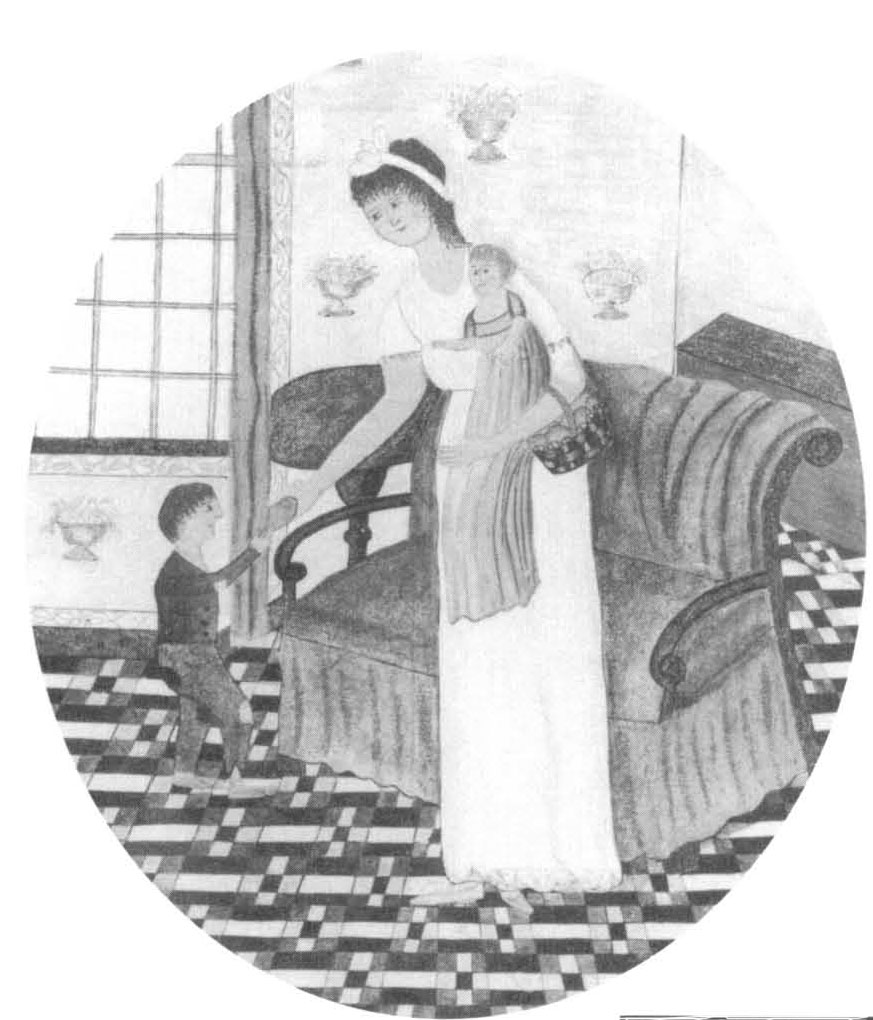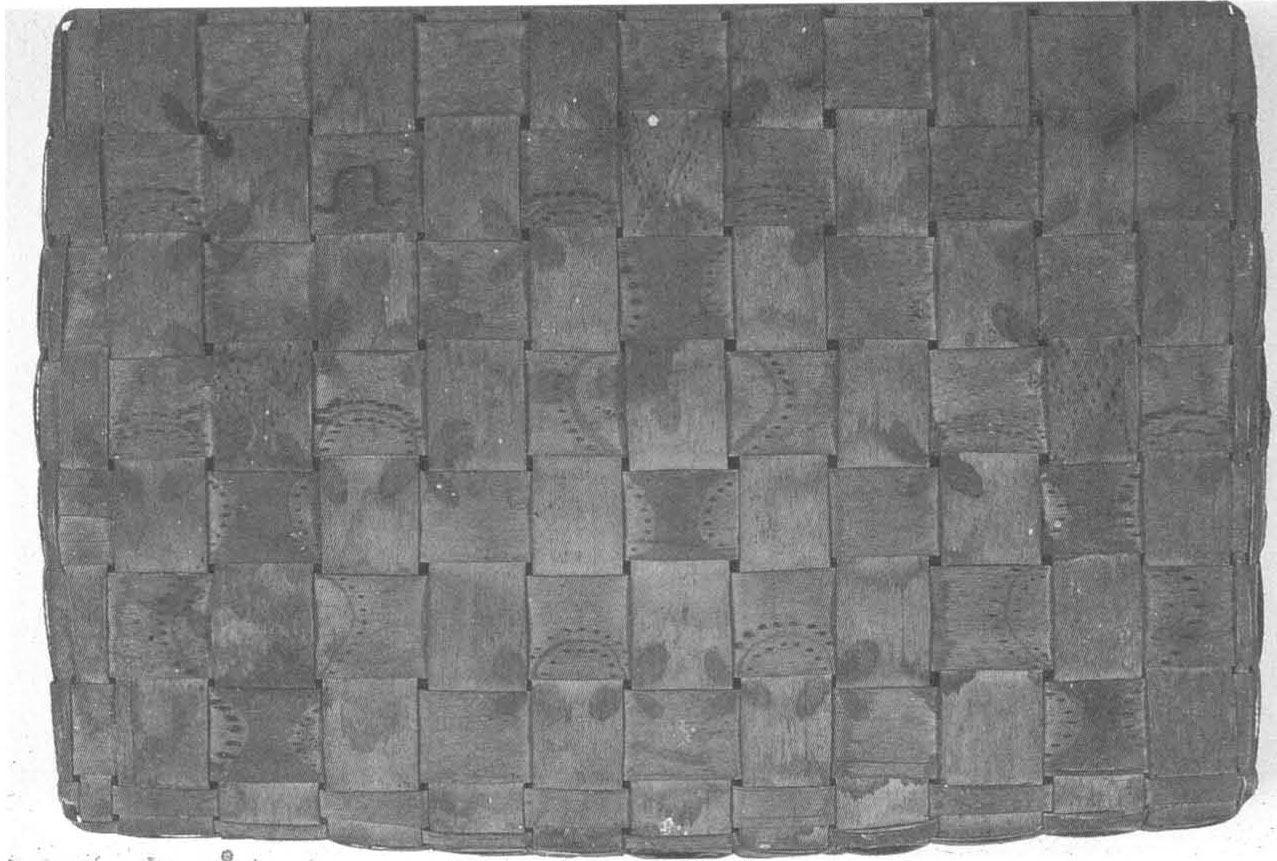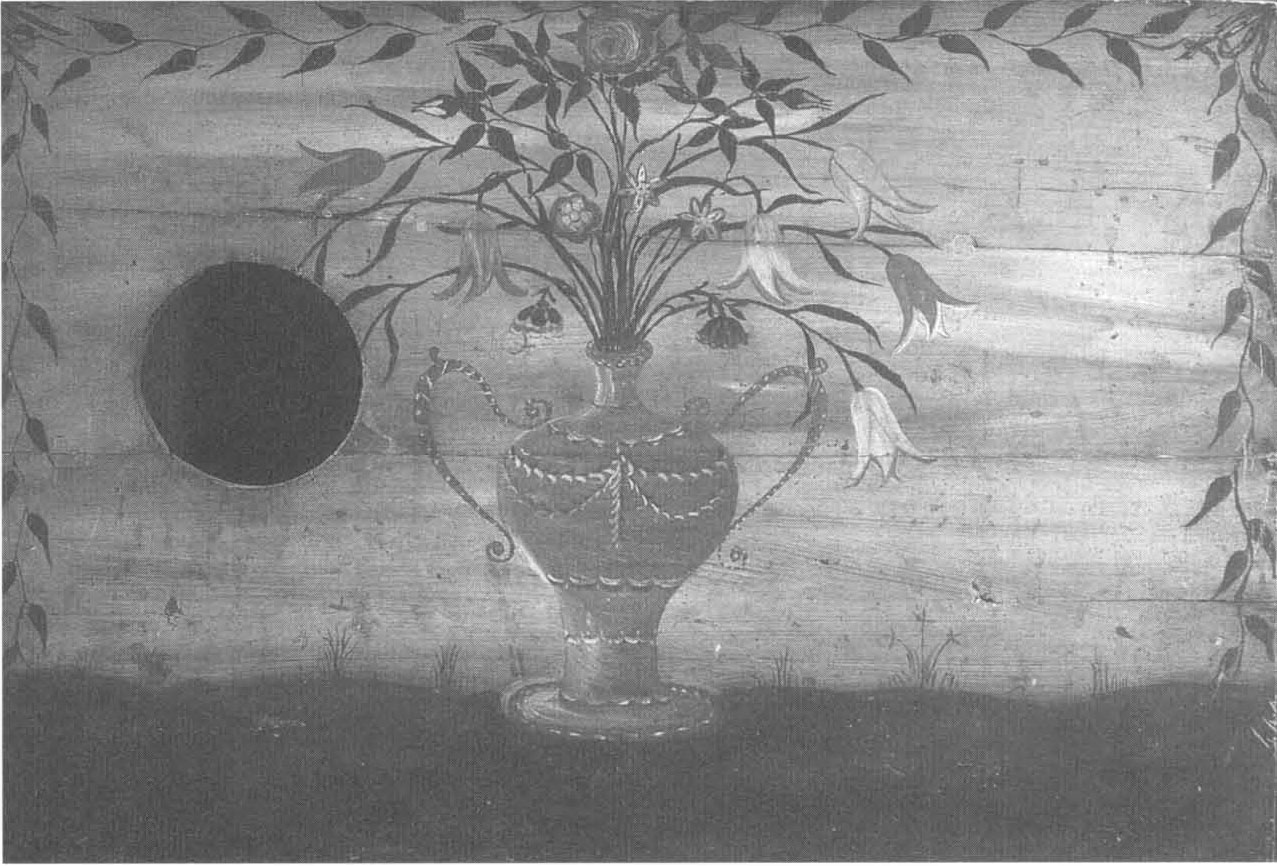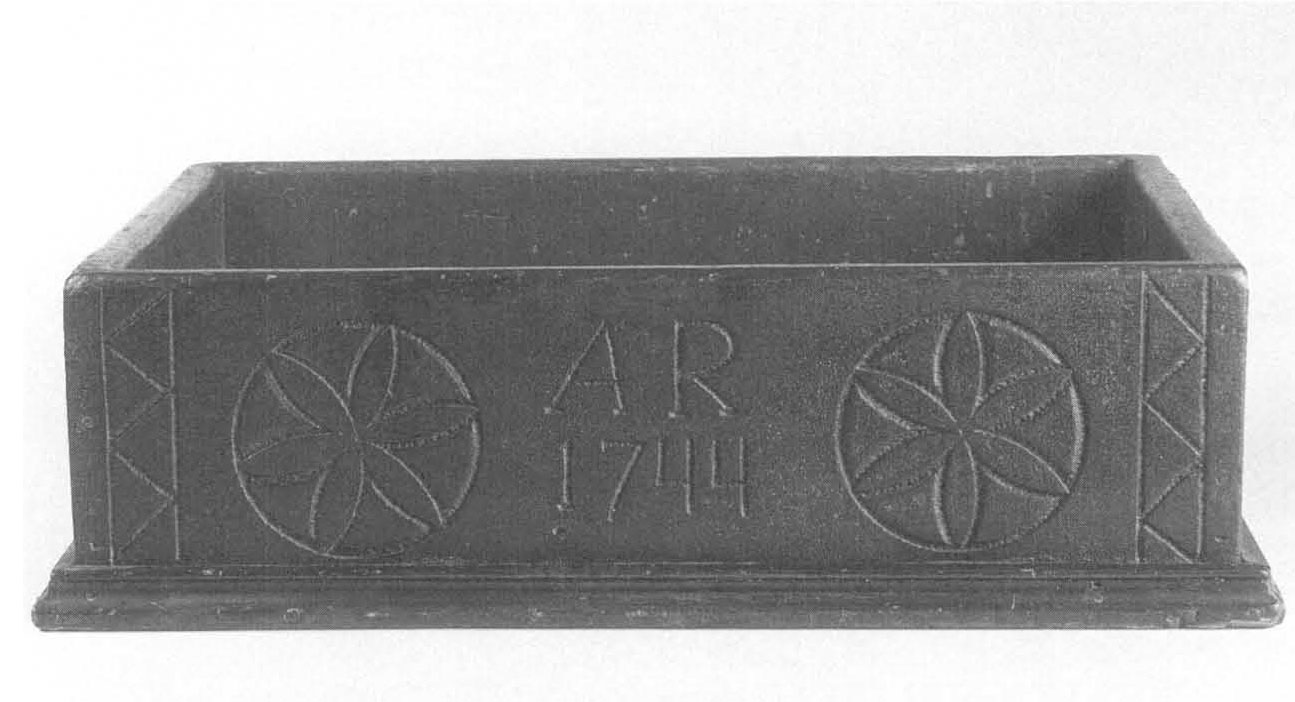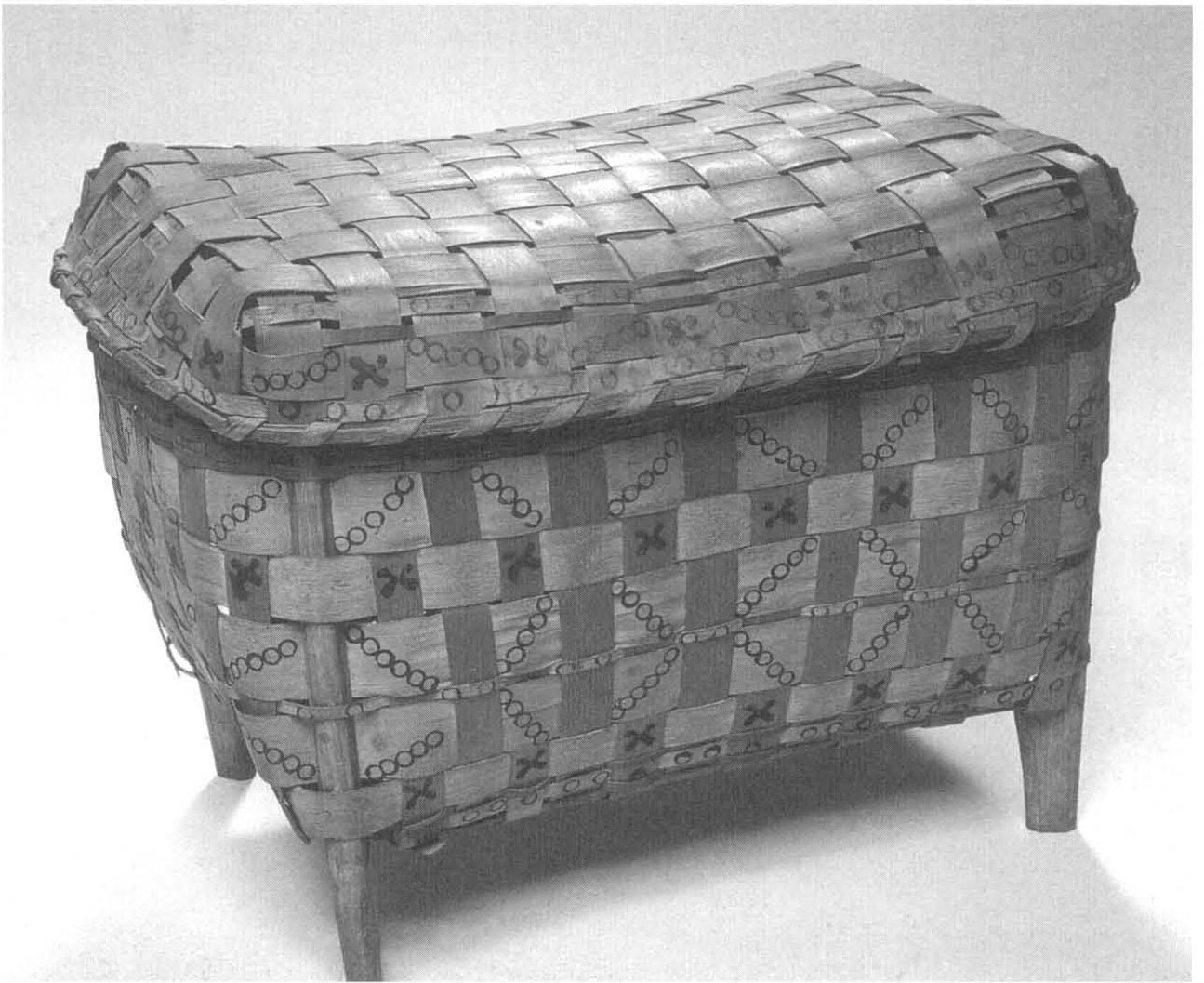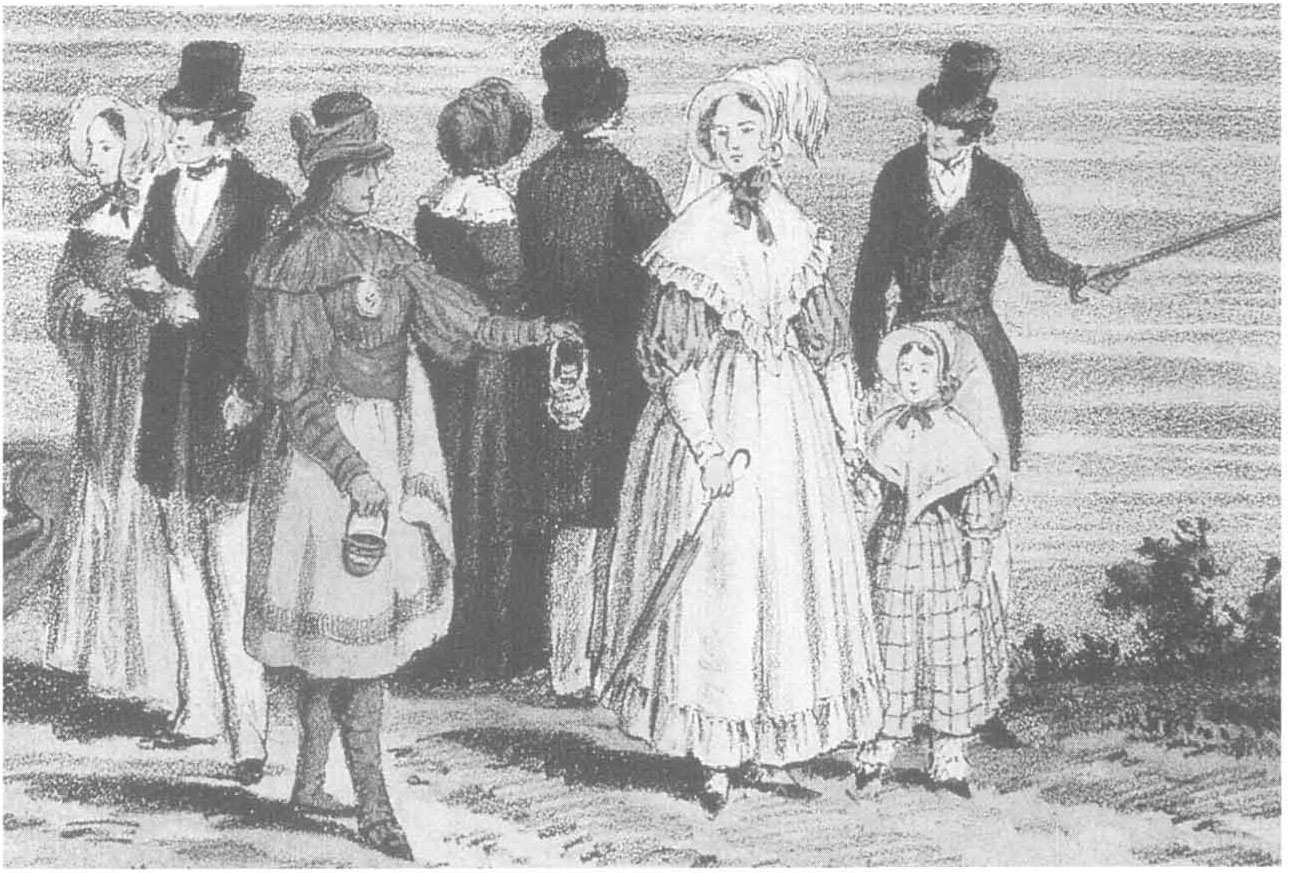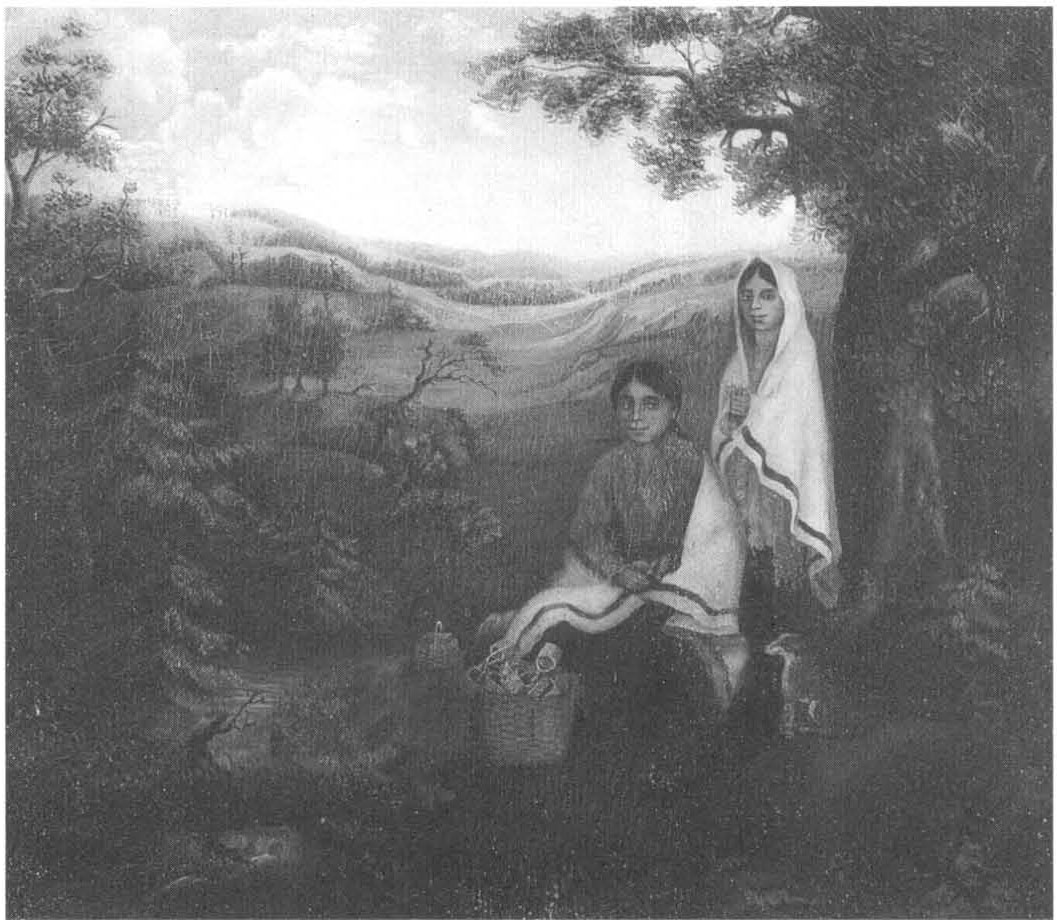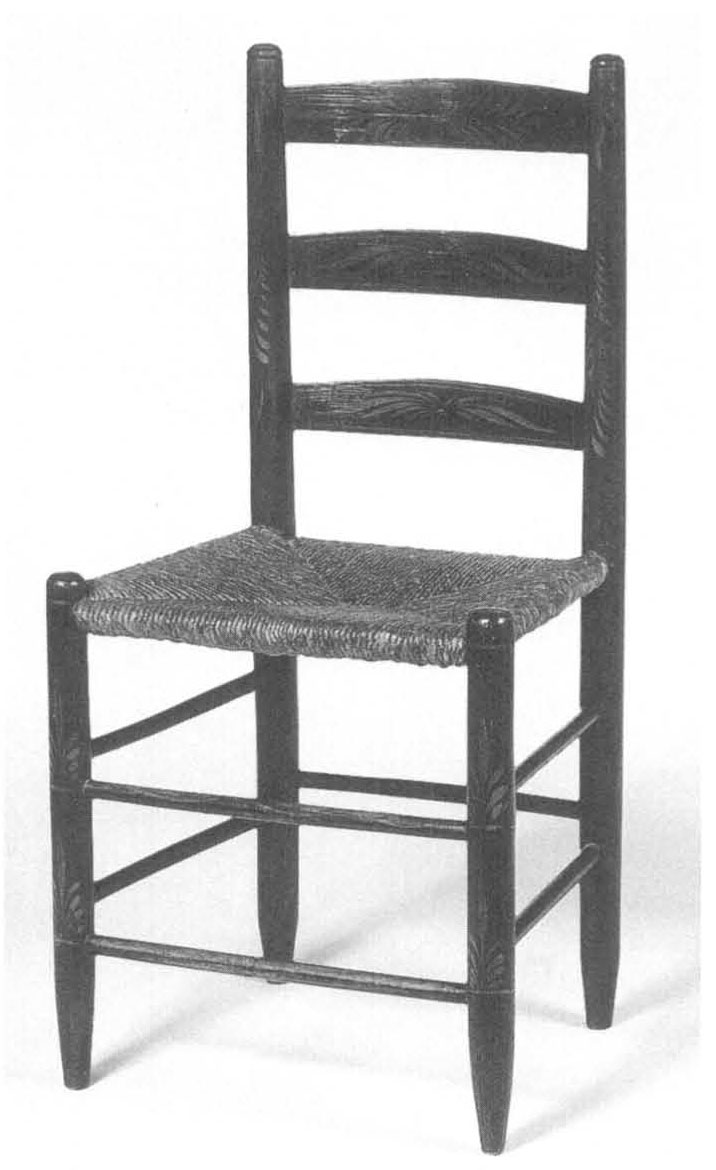“A Precarious Living”:
Basket Making and Related Crafts Among New England Indians

Nan Wolverton
When Joseph McKinstry of Sturbridge, Massachusetts, died in 1804 at the young age of thirty-seven, he had among his belongings some thirteen baskets. The appraisers of McKinstry’s estate valued most of them at roughly five cents apiece.1 The number of baskets listed among the pounds of wool and flax and bushels or half bushels of beans, malt, rye, and corn suggests how important they were for the work of Yankee farmers like McKinstry, who used them for storing and transporting a wide variety of products.2 But the low values assigned to these vessels, which were labor-intensive to produce, reflect on another group of workers that operated within the same web of social and economic relations as McKinstry’s farm. The makers of baskets like those owned by McKinstry were often marginalized craftspeople, many of whom were Native American. This essay considers the shared experiences of Indian and non-Indian basket makers, in an attempt to understand how Indian artisans fit into an economy that demanded cheap labor from marginalized workers producing inexpensive, necessary goods. In addition to crafting baskets, these same individuals often practiced trades such as chair bottoming, broom making, and mat making to eke out livings. Recognizing the significance of these crafts alongside basket making helps us to gain a better understanding of how, in eighteenth- and nineteenth-century New England, many Native Americans utilized local, natural materials to earn livelihoods that in turn helped sustain their identity as Indians.
What do we know about itinerant basketmakers in early New England? In most cases they were craftspeople who were politically, socially, and/or economically marginalized. Many, especially Indians, were literally living on the edge of white New England society—some lived within swamps, some in shacks—but they were nonetheless participants in an economic network. They traded their handmade goods as a necessary means of eking out what might easily be described as a “precarious” existence. Many who took up basket making and related crafts did so as the only available means of making a living. The plight or Yankee basket makers in early nineteenth-century York, Maine, is clear from a footnote to the manufacturing census of 1832: “The basket makers are indigent persons, living in the back part of the town, on rocky sterile land, who employ themselves in making baskets, as the only means of affording a living.”3
A common trait among most of those who made baskets was the ability to practice more than one craft—chair bottoming, broom making, and mat making were among these other activities. The Nedson family of Southbridge, Massachusetts, for instance, were Indians who lived near Hatchet Pond, where they existed by “swingling flax, chopping wood, weaving baskets and chair-bottoms.”4 Simon Gigger and Bets Hendricks were remembered in antiquarian Harriette Merrifield Forbes’s history of Westborough, Masssachusetts, as Nipmucs who made baskets and “often found work in rebottoming the chairs.”5 Peter Salem, who served as a soldier during the Revolutionary War, was a former black slave who earned “a precarious livelihood by making and mending baskets, bottoming chairs, and the like.”6 Yankee Judah Wright of Holden, Massachusetts, born in 1774, was blind from the time he was an infant. From age twelve, following the death of his father, Judah supported himself and his mother by making baskets and bottoming chairs.7 Nathan Hunt from Boscawen, New Hampshire, was a Yankee noted for his strong and evenly woven baskets. He reportedly earned “a precarious living by making baskets and bottoming chairs.”8 Sylvester Judd, author of the History of Hadley, noted that “Indians and squaws peddled brooms and baskets” in Hadley, Massachusetts, and other towns [Figure 1].9 In her account of the characters of South County, Rhode Island, South-County Neighbors, Esther Bernon Carpenter introduces Ailse Congdon, whose dooryard was always “guiltless of litter” since its short grass was fiercely swept with the birch brooms brought to the door by “the sullen lords of the Charlestown squaws, who, at other seasons, tramped with baskets.”10 In his 1895 reminiscence of his native Williamstown, Massachusetts, Judge Keyes Danforth recalled that among the town inhabitants was the “Ballou” family, who lived in a shanty and “eked out a miserable existence by making door mats of corn husks and coarse baskets.”11 Danforth describes the Ballous as a “poor white family” who “for many generations annoyed the people of the village with their begging.”12 The local Williamstown history describes the Ballou family of mat and basket makers as “whitish mulattoes” or as “very dark whites” and “extremely dirty in either case.”13 Both writers considered this family a nuisance because of their begging and abject poverty and perhaps because of their uncertain racial identity.14
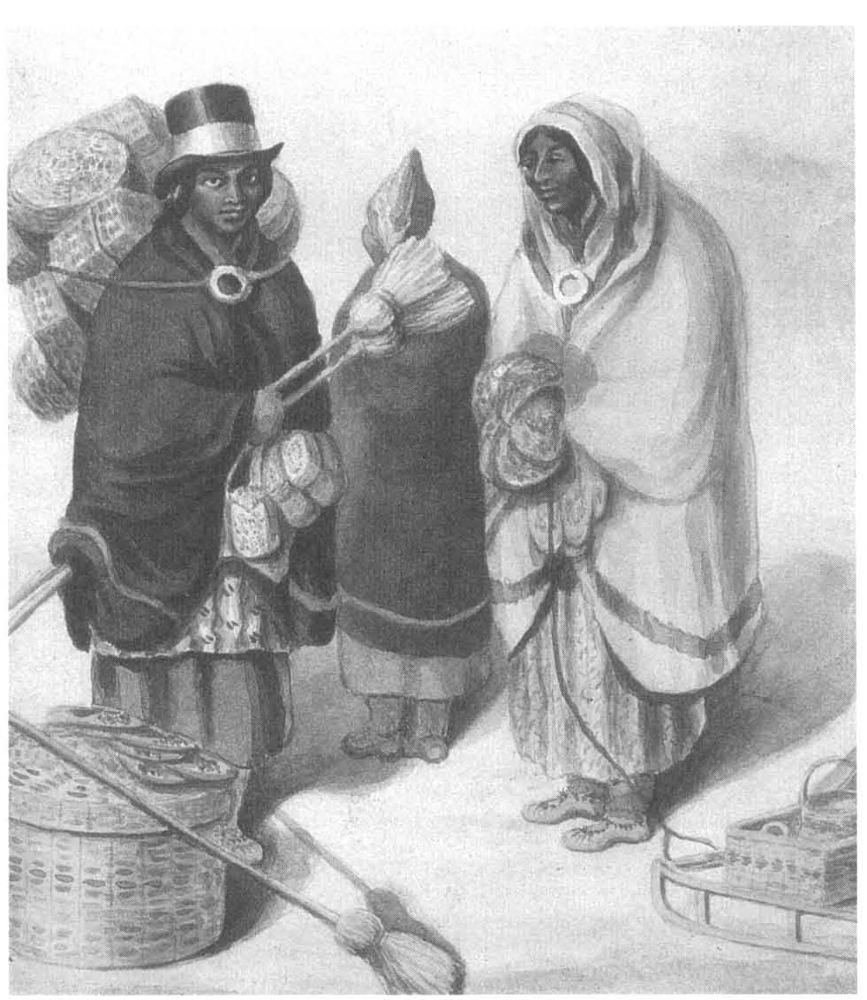
Figure 1: Three Maliseet women peddling basket and brooms, c. 1840, watercolor by John Stanton. Photo courtesy of The New Brunswick Museum, Webster Canadiana Pictorial Collection, #6712.
It is clear from references to both Indian and Yankee itinerant basket makers and bottomers in nineteenth-century century local histories that, although members of both groups shared a common social class, poverty, and to some extent ridicule as peculiar local “characters,” in other ways they were nevertheless distinct from one another in the eyes of nineteenth-century town historians. The Yankees were often remembered as local geniuses who made up for their lack of education with wit or natural ability, as harmless individuals who practiced a craft to get by. John Davis of Gilsum, New Hampshire, was, according to the town history, “quite a remarkable man.” He was a mechanical genius who had made a stringed instrument that resembled a piano. Yet in 1815, he reportedly walked to Keene barefoot to seat chairs to earn enough money to pay his taxes. Yankee Stephen Messer, of Gorham, New Hampshire, was remembered for his natural mechanical and artistic skills: “no one could make a handsomer basket, snow-shoe or moose-sled, or bottom chairs with more artistic skill.”15
Indian makers were more often noted for their itinerant lifestyle and fondness for rum and cider than for their craft skills. “Like all the Indians,” Forbes generalized as she wrote of Andrew Brown and other Indians who lived in Westborough in the nineteenth century, “he and his family spent their time making baskets and drinking up the profits from them.”16 Forbes’s racism and condescension are representative of most descriptions of Indian basket makers in local histories and memoirs. In 1897, The Warren Herald published the recollections of Emily Allen Woods, who, as a child in Brimfield, Massachusetts, remembered that the Dorus family “made a few baskets which they traded mostly for rum.”17 Certainly Yankee basket makers indulged in alcohol as well. Yankee Nathan Hunt, for instance, was a basket maker known among his customers for his procrastination and drinking habits. It was, however, Indian makers, at once marginalized because of their race, who were stereotypically associated with alcohol in local history descriptions.
The above-mentioned itinerant makers are just some of the many artisans in nineteenth-century New England who made baskets and related crafts. Many makers were part-time producers, while others devoted most of their time to their craft. Some had no choice but to turn out these products.18 Early nineteenth-century institutions forced juvenile delinquents and prisoners to make baskets, bottom chairs, and practice other trades in an attempt to teach them skills but also to provide some income for the facilities that housed them. These children provided cheap labor that helped such institutions support themselves. The Juvenile Institution of South Boston reported that there were fifteen boys employed at basket making as of January 14, 1829 and that after they had worked forty-two days the institution garnered $4.20 for the baskets they produced.19 Prisons employed inmates in a similar fashion to reform schools and houses of correction. In the 1830s and 40s the inmates of the Connecticut State Prison in Wethersfield were employed at making chair bottoms and at other activities such as shoe and nail making, all of which helped maintain the institution. In the 1840s, female inmates at the Wethersfield prison were also weaving chair bottoms. Contractors worked with the agents of such institutions to receive and sell the products, and the market determined what was produced.20
Women and girls also routinely performed chair bottoming as outwork for chair factories in northern Worcester County throughout the nineteenth century.21 Covering glass bottles with willow or wood splint to protect them from breaking was another, related activity that women took on as outwork for some glass factories, and juvenile delinquents also performed this task at Houses of Refuge.22 It has also been suggested that Indians were sometimes employed by glass factories to weave basket-covered bottles, perhaps as outwork.23
What was it about crafts such as basket making and chair bottoming that relegated these activities to poor, marginalized artisans and even prisoners? These products took time to make, but brought in low returns. Prices varied depending upon the size of the product and when and where it was sold, but usually ranged from two cents to seventy-five cents per object. Paugusett Molly Hatchett, for instance, is said to have received four cents for one of her baskets around 1800. In 1733 Mohegan Sarah Cooper received from sixteen to forty-eight cents for her baskets, depending upon their size.24 Peter Salem received twenty cents for bottoming a chair in 1806.25 Jonas Clapp, a Yankee basket maker from Oakham, Massachusetts, received fifty cents for a bushel basket and seventy-five cents for a two-bushel basket in 1834. For his smaller, handled baskets he received twenty-five cents and for a cheese basket thirty-three cents in 1835.26 A uniform price for making splint brooms for country stores throughout Vermont in the late 1820s was six cents. Indian women peddled such brooms for nine pence apiece.27
These trades were not hard to learn (hence they could easily be taught to juvenile delinquents), but it took time to learn to practice them well. The work was tedious, and for those who gathered raw materials or peddled their own wares, it was also strenuous. Baskets and brooms were both crafted at home or while traveling, and then peddled to households near and far [Figure 2].28 John Johnson, who grew up making and peddling baskets as an Indian captive in Maine, recalled in his narrative published in 1861 that peddling baskets was “a hard life, and although a person might be very tough, yet this kind of life followed up pretty closely, would wear upon him.”29
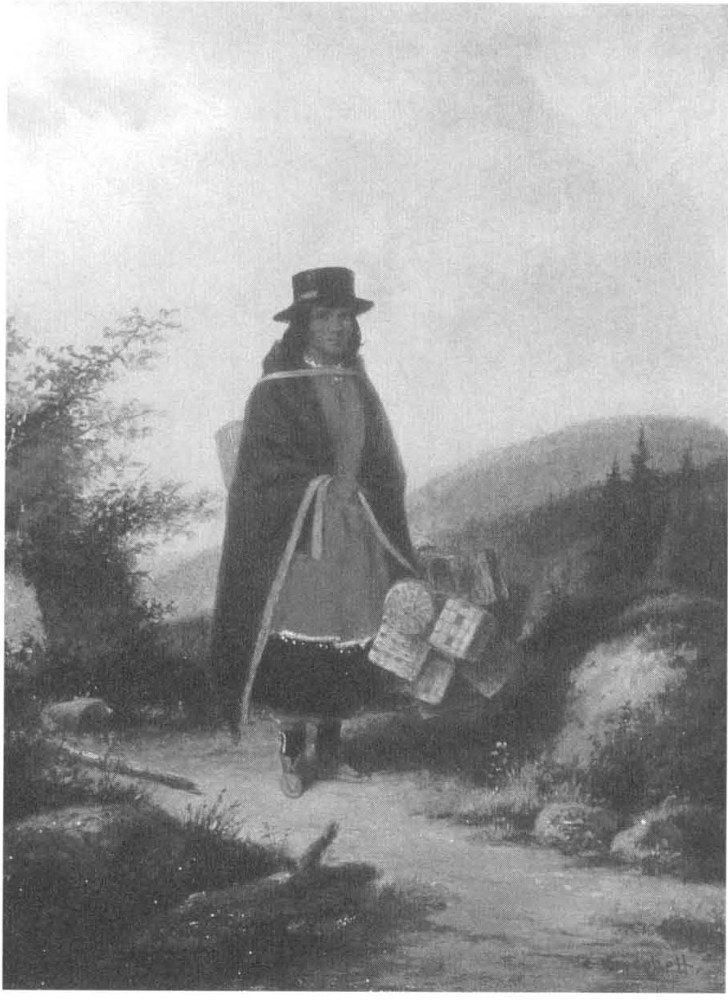
Figure 2: Indian woman peddling baskets, watercolor by Cornelius Krieghoff. Photo courtesy of National Archives of Canada, Ottawa.
Trades like basket making, chair bottoming, and broom making involved minimal or no expenditure for materials, which could usually be gathered locally at no cost. The wood splint used for baskets—usually brown ash, white ash, or white oak—was the same material used for splint chair seats or bottoms. The checker weave of splints woven in an “over one, under one” pattern used on baskets was related to that used on many splint chair bottoms. In some cases inventories even make reference to the similarity. The probate inventory of Nathan Fiske of Sturbridge, Massachusetts, for instance, indicates that he had two dozen “basket bottom chairs” in his household when he died in 1829.30 The most common weave used on chair bottoms was a twill weave—splints woven “over two, under two” (or “over three, under three”) to create a twill design. This type of weave was sometimes used on baskets as well.
While making flag seating does not resemble wood splint basketry or bottoming in its technique, it is similar in its economy of materials. The technique for flag, or rush, seating involves twisting wet rush and pulling it around seat rails to create the woven seat. Making flag-bottomed chairs, commented one nineteenth-century observer, was a “common trick of economy.”31 The materials for flag chairs—sweet flag, cattail, rush, or corn husk—could be gathered locally and could also be used for making mats. Lydia Howard Sigourney reminds readers in her Sketch of Connecticut, Forty Years Since that neat farmhouses in New England had white sanded floors and broad mats made of the husks of Indian corn at each door.32
Brooms were made from ash or birch. What had come to be known as “Indian,” “peeled,” or “splinter” brooms were made from sticks of birch or ash long enough to include the broom and the handle. The brooms were made by slivering thin splints from both ends of the base stick, with one set turned down upon the others until a thick, round broom was formed—all this from a single stick of wood. When Yankee Levi Dickinson began a broom business in 1797 in Hadley, Massachusetts, he was scoffed at and told that only Indians made brooms.33 What Dickinson set out to do, however, was to make brooms from broom corn rather than from ash or birch. Dickinson was attempting to develop a business in brooms that required that he grow his materials rather than gather them from the wild—an altogether different enterprise.
It was the demand for such everyday, utilitarian products as baskets and brooms that helped keep their makers in business. These products were among the most common objects in New England households. Chairs, the most numerous pieces of furniture in the home, often were bottomed with flag seats that wore out with use and had to be replaced, sometimes several times during the life of a chair. Having a chair rebottomed was much cheaper than purchasing a new one. Brooms and mats, too, were common, everyday items used in New England households, and because they wore out they had to be replaced with some regularity. Repeat customers, therefore, were common. Some makers followed familiar circuits in order to deliver their goods to the same customers on a regular basis. Molly Hatchett of Derby, Connecticut, well known for her little fancy stained baskets, visited one hundred or more families once or twice a year. She came to know the families well and would routinely deliver a basket rattle [Figure 3] containing six kernels of corn when any one of them welcomed a new baby.34
Baskets had many functions and were used in every part of a household, from the woodshed to the parlor.35 Probate inventories from the eighteenth and nineteenth centuries indicate not only how common baskets were, but also the variety of their uses. Examples include “basket of feathers,” “basket of knives and forks,” “two baskets and wool,” “basket, clothespins & line,” “basket & old clothes,” “basket and tools,” and even “a basket of powder, files, awls, borer, etc.”36 Households could easily have had ten or more baskets on hand. Clothes baskets and bushel baskets were among the most common. Other types included cheese, fruit, knife, corn, and sewing or workbaskets, hat and bonnet baskets, and eel pots.37
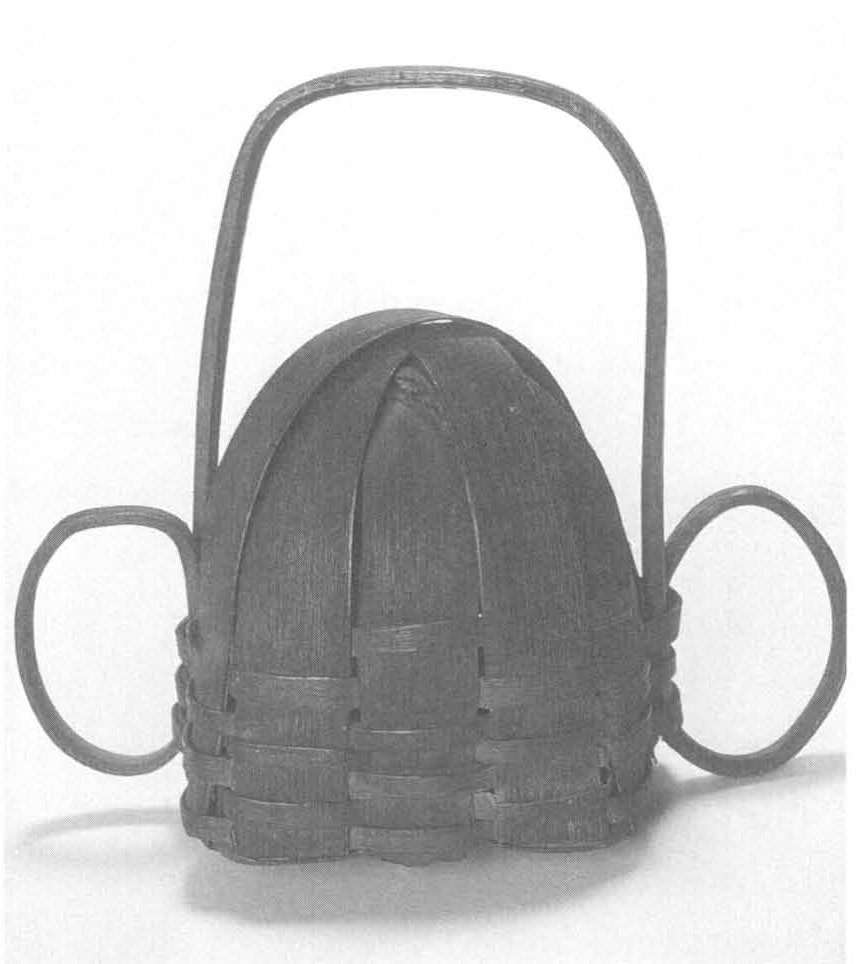
Figure 3: Wood splint rattle attributed to Molly Hatchett. Photo courtesy of Old Sturbridge Village.
Rarely do we find baskets described as “Indian” in probate inventories, although occasional examples exist. Some entries only suggest Indian makers: a “colored basket and contents,” for instance, worth ten cents in the 1837 inventory for Prudence Clark of Sturbridge, Massachusetts, may refer to a paint-decorated Indian basket.38 Because they were so common, Indian baskets may not have warranted special mention in probate listings. We do, however, see them included in period paintings such as the watercolor of “Charity,” showing a Connecticut interior, c. 1810 [Figure 4] or the girl with a stamped splint basket of fruit and corn, c. 1830–35 [Figure 5].
Figure 4: “Charity,” c. 1810, artist unidentified, watercolor with crystalline decoration. Photo courtesy of New York State Historical Association.
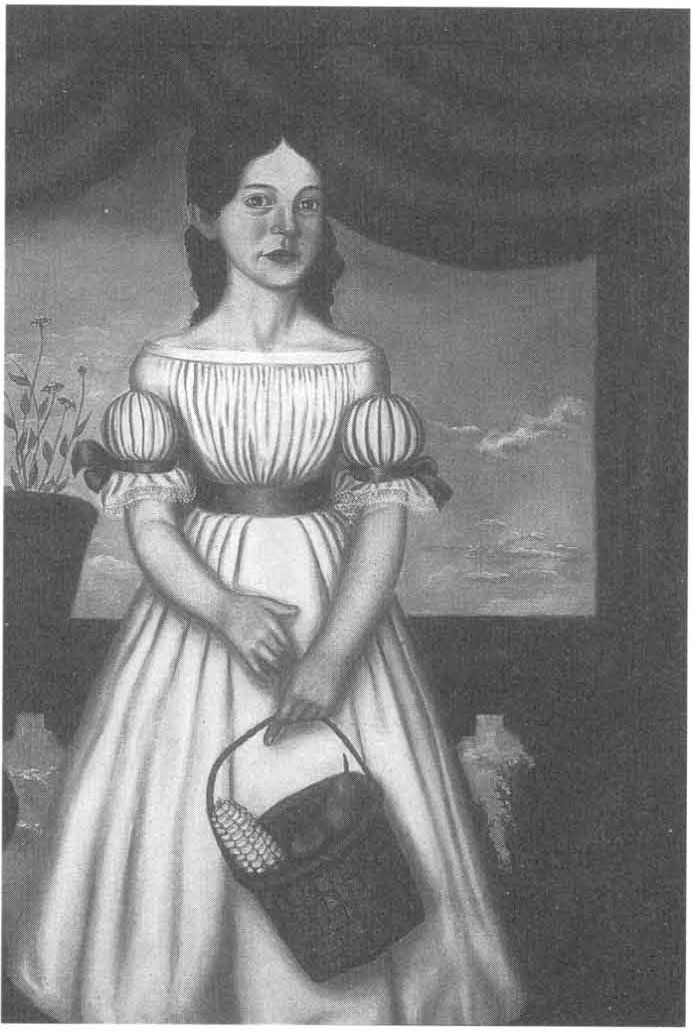
Figure 5: “Girl with Painted Splint Basket of Fruit and Corn,” c. 1830–1835. Private collection.
Figure 6: Cover of wood splint basket showing painted vase design. Photo courtesy of Old Sturbridge Village.
As commodity goods, Indian baskets were often specifically designed to cater to the Euro-American market in ways that set them apart and were intended to increase sales.39 Makers sometimes employed design motifs that were commonly found on other forms of decorative arts within Yankee households. Baskets with hand-painted designs of vases with flowers, for instance, have been attributed to the Arnold family that lived at Hassanimisco, near Grafton, Massachusetts [Figure 6].40 Fireboards painted with vases of flowers may have been among those objects that inspired such designs [Figure 7].
Some baskets combined traditional Native American with European inspired designs. A geometrical rosette or compass pinwheel inscribed on a basket [Figure 8] may have been inspired by the use of the motif in other common contexts such as on a Bible box [Figure 9]. The stockade design on the same basket is a traditional Indian motif whose symbolism varied from one group to the next. The juxtaposition of both designs on the same basket is a good example of how Indian basket makers combined motifs from two traditions [Figure 10].
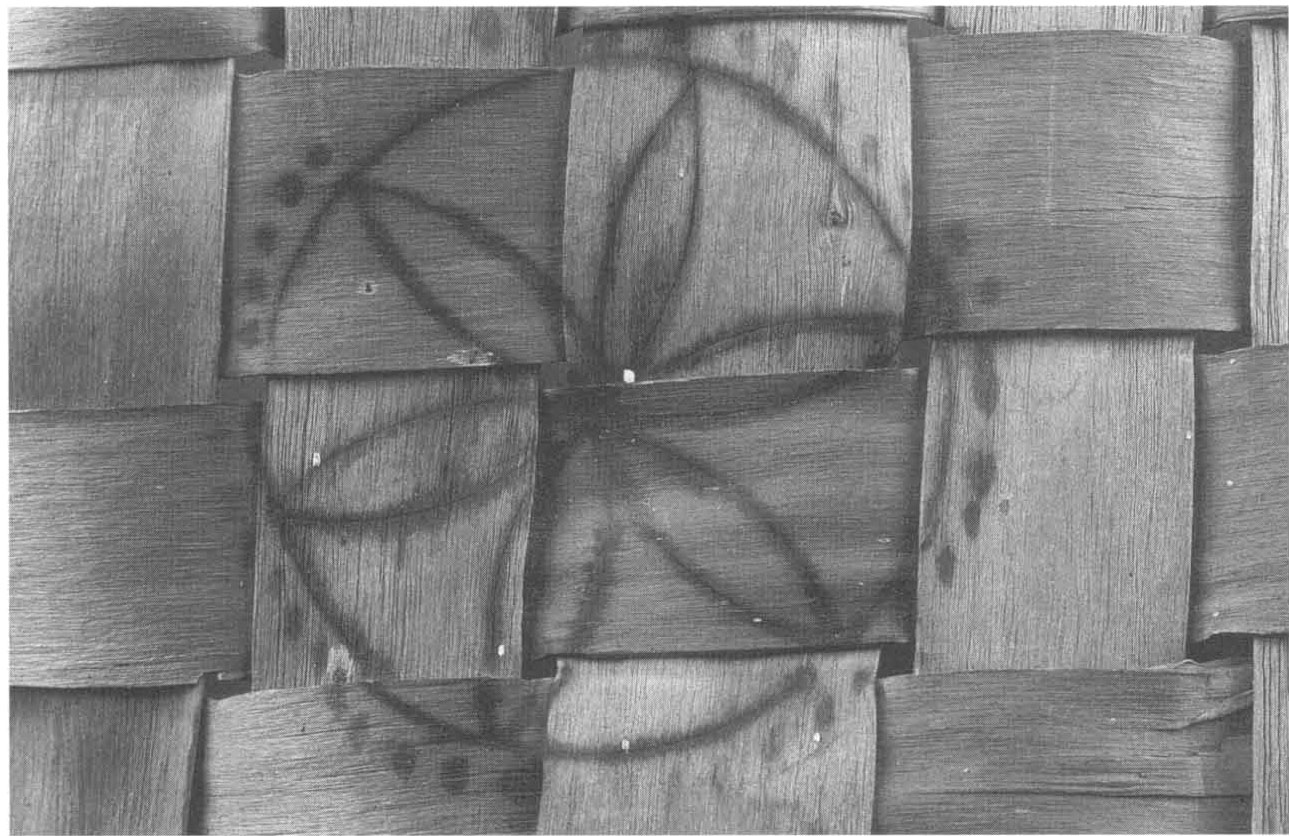
Figure 8: Basket detail showing inscribed geometrical rosette. Photo courtesy of Old Sturbridge Village.
Figure 9: Bible box dated 1744 with carved geometrical rosettes. Photo courtesy of Old Sturbridge Village.
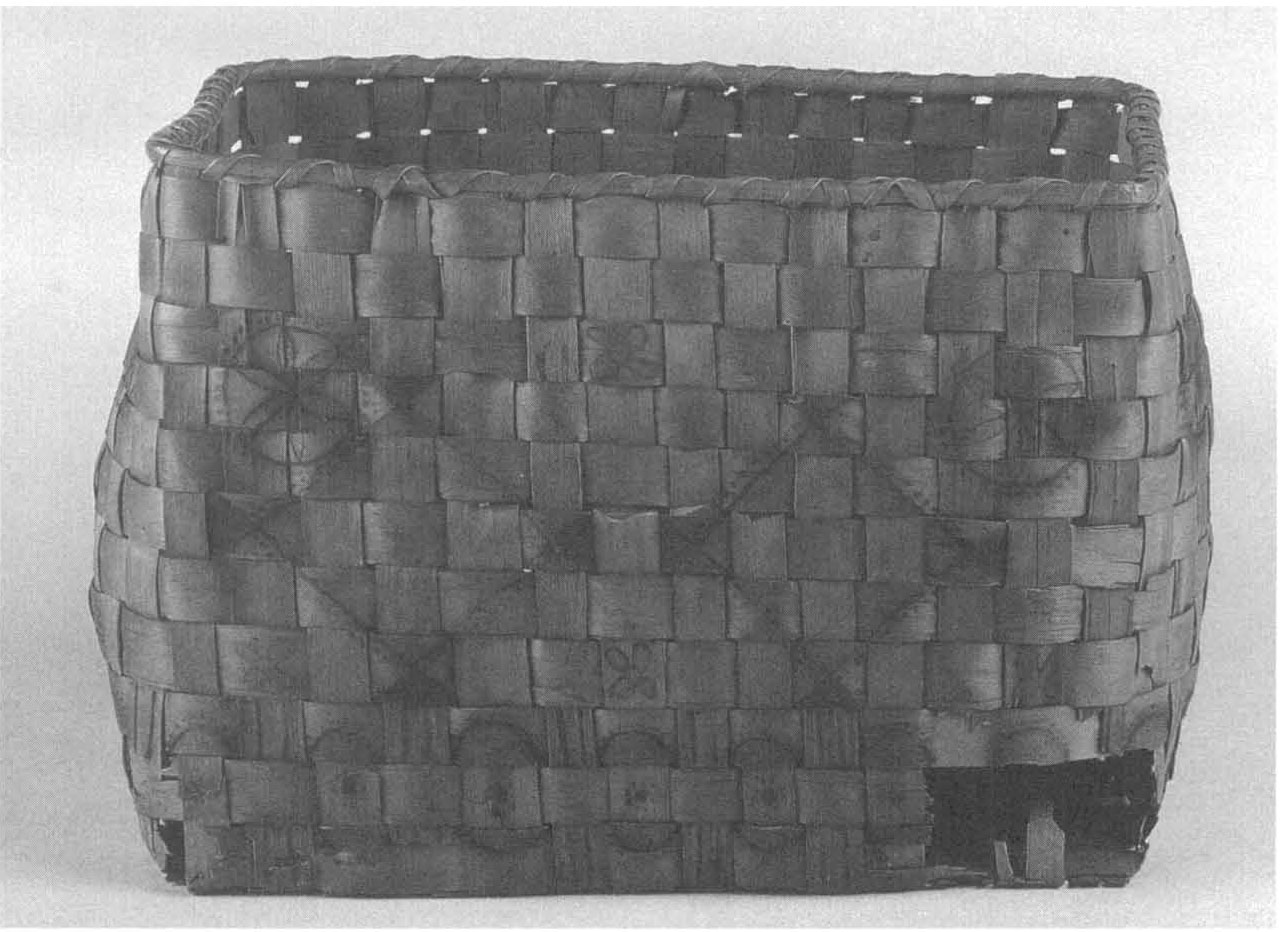
Figure 10: Wood splint basket showing traditional Native American and. European motifs. Photo courtesy of Old Sturbridge Village.
Figure 11: Chest-like storage basket with painted and stamped decoration. Photo courtesy of Old Sturbridge Village.
While many baskets had freehand decoration (applied with a brush or a chewed twig), there were also many with stamped decoration—a technique that speeded up the decorating process and, hence, the number of baskets that one could produce. Forms also occasionally reflected market demand. Storage baskets with legs imitating chests were made in both decorated and undecorated styles [Figure 11]. In addition, “fancy” souvenir baskets were developed and sold to the growing tourist industry by the mid-nineteenth century [Figure 12].41
Not all Indian-made baskets were decorated, so baskets of Indian manufacture are not always obvious. John Avery noted in the History of the Town of Ledyard that the Indians made baskets of all shapes and sizes, “from tiny ornamental ones holding only a pint or even less up to strong oaken baskets for farm use, holding one or two bushels apiece.”42 A painting depicting two young Indian girls peddling a variety of basket types includes both decorated and undecorated baskets [Figure 13]. The knife inserted in the front of the large basket suggests that the girls were making or refining baskets as they traveled.
Like basket makers, chair bottomers traveled to the homes of their customers, and there they performed their craft, often telling stories simultaneously. By spending many hours within the family circles, these artisans often earned the respect and friendship of their customers through their work and their stories. Chair bottomer Peter Salem’s trade gave him admittance to everyone’s home, where “his good nature rendered him a universal favorite, especially with the children.”43 While Peter was engaged in mending household chairs, children gathered around him to listen to stories of his service as a soldier during the Revolutionary War.
Figure 13: Two young girl basket peddlers, first half of the nineteenth century. Private collection.
Rarely are the makers of particular chair seats known today, since their work was unmarked. Some material evidence remains, however, to provide an understanding of how even a seemingly anonymous product can be identified with its maker. Sarah (Brown) Sprague, an Indian woman also known as “Granny Sprague,” made a living in the early nineteenth century by selling baskets and seating flag-bottomed chairs for white families in and around Webster, Massachusetts. What little we know of Sarah comes from recollections written by Octavia Sweetser, who had been a good friend of Sarah’s granddaughter, Angela Sprague. Mrs. Sweetser’s recollections indicate that Sarah—a Nipmuc Indian—traveled quite a distance to market her wares, including the ten miles to Sturbridge where among her regular customers was the family of Samuel F. Bemis.
Figure 14: Ladder-back side chair seated by Sarah (Brown) Sprague, also known as “Granny Sprague.” Photo courtesy of Old Sturbridge Village.
Sarah’s son Israel and his wife, Sally White, died at early ages, leaving two young daughters behind. The youngest, Angela, was cared for by her Grandmother Sprague. So well did Granny Sprague come to know the Bemis family for whom she bottomed chairs that after her death sometime in the 1860s, Angela was sent to live with them. Although raised in a white family and later married to a white man, Angela remained quite aware of her Indian identity as it had been passed on to her by her grandmother. According to Octavia Sweetser, another ward of the Bemis family, Angela accompanied Granny on her basket-selling/chair-seating circuit. Angela also helped her grandmother, for she well remembered handing her rush as she worked.
Granny Sprague’s seating work must have seemed to Angela an important part of her grandmother’s identity as a Native artisan, for following Granny’s death, Angela asked to keep as her own two of the chairs that the old woman had seated. Years later, nearly a century after Granny’s death, they were donated to the Old Sturbridge Village collections by Octavia Sweetser, to whom Angela had willed them [Figure 14]. These neatly seated chairs had been kept as a sort of memorial to Granny Sprague and were donated to the museum along with her story. Granny Sprague was just one of many Indian women who had bottomed chairs during the two hundred years prior to her death. A rare, early reference to a rush chair bottomed by an Indian woman appears in a 1672 account book and simply states, “woven by Indian squa[w] Hanna.”44
Certainly not all Indians made baskets and bottomed chairs, but for many these trades became a means of subsistence and even resistance as their land and other traditional means of living were lost to European encroachment. The object of making these crafts wasn’t just to supply the market, as it was for many non-Indian producers. For Indians, the use of local, natural materials to create objects that could be sold or exchanged for goods helped to maintain at least some element of their traditional economies. Even crafts that were virtually anonymous, like chair bottoming, helped some individuals—including, perhaps, Sarah (Brown) Sprague—to find an identity in a world that had seemingly turned on its head. One might argue that the mobility that accompanied such crafts allowed Indians the freedom to work at their own pace without being tied down by the demands of other forms of labor. Some Indians considered it a natural right to gather materials for their crafts wherever they might be located. Emily Allen Woods, who grew up in Brimfield, Massachusetts, recalled that Indians in that vicinity “never hesitated to cut a tree for basket stuff when they saw one they wanted, no matter whose land it was on.”45 This practice was common enough to prompt the author of a history of Windsor, Connecticut, to note in 1859 that there was still a “prevalent impression” among the people of New England that Indians had a hereditary right to cut trees for baskets and brooms within the domains once owned by their ancestors.46 And, as Ann McMullen has demonstrated, the decoration on some Indian baskets suggests a culture of resistance.47 The very practice of these crafts as a means of livelihood, then, might be seen as a form of resistance to the dominant Euro-American economic and social systems.
In Oldtown Folks (1869), Harriet Beecher Stowe describes the early nineteenth-century descendants of the Natick Indians as a “roving, uncertain class of people, who are always falling into want, and needing to be helped, hanging like a tattered fringe on the thrifty and well-kept petticoat of New England society.”48 This perception of Indians as needy and dependent made many white New Englanders feel superior to the Natives in their communities. Yet the products of these Indians and other marginalized workers were essential to the everyday economies of New England households. Indians, in fact, helped to maintain the “well-kept petticoat of New England society” with their baskets for keeping things orderly, their newly woven chair seats, their mats for wiping dirty feet, and their brooms for sweeping up. In the process, these crafts, among Natives and non-Natives alike, became associated with Indian cultural identity.
It was, ironically, the Indian as icon of tradition that some twentieth-century marketers used to help sell factory-produced baskets, the very wares that by the end of the nineteenth century had forced many Native Americans to find other means of economic survival.49 The cover of an early twentieth-century catalog for the Shelton Basket Company of Shelton, Connecticut [Figure 15] presents a romanticized image of an Indian basket maker that helped to sell the factory’s products because it suggested basketry as a time-honored craft—indeed, as “America’s first industry.” The image also helped to suggest high quality by implying handmade, Indian construction even though the items in the catalog were neither Indian nor hand made. Even after consumer demand for their handmade products had ceased, Indians continued to pass their craft traditions on to future generations, as part of their Native American identity if no longer as a means of existence.
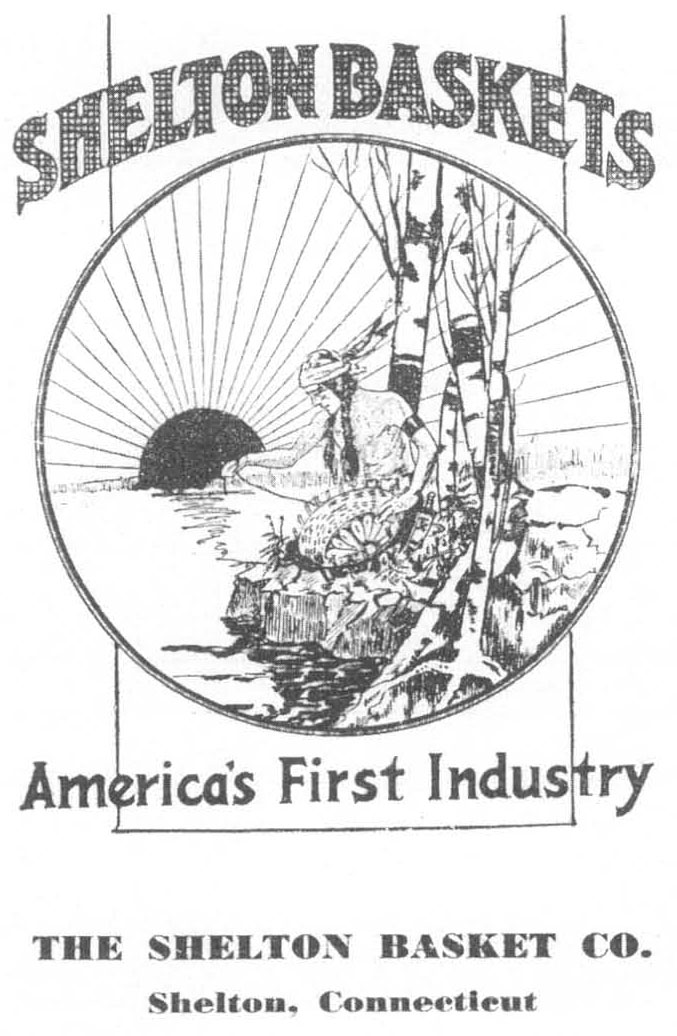
Figure 15: Cover of advertising pamphlet for Shelton Baskets, c. 1900. Photo courtesy of Connecticut Historical Society.
Notes

1. Ten of McKinstry’s baskets were valued collectively at fifty cents, making them worth about five cents each. Joseph McKinstry inventory, 33, p. 129, Worcester County Probate Records, Office of Probate, Worcester County Courthouse, Worcester, Mass. (Worcester County probate records referenced in this essay were transcribed by Holly Izard).
2. McKinstry also owned a cheese basket for straining whey from cheese curds and a “knife and comb basket.” An unmarried farmer, he did not apparently own many of the common household baskets such as sewing or clothes baskets.
3. Documents Relative to the Manufactures in the United States (Washington, D.C., 1833), 27.
4. Ellen D. Larned, History of Windham County, Connecticut, 2 vols. (Worcester: published by the author, 1880), 2:532.
5. Harriette Merrifield Forbes, The Hundredth Town: Glimpses of Life in Westborough, 1717–1817 (Boston: Rockwell and Churchill, 1889), 174.
6. Emory Washburn, Historical Sketches of the Town of Leicester, Massachusetts (Boston: 1860), 267. Salem was remembered for having shot down Major Pitcairn at the Battle of Bunker Hill. Peter Salem’s livelihood was, indeed, precarious. As he grew older, his resources grew smaller, and he was unable to supply his few wants. The overseers of the poor for Leicester, unwilling to provide charity for the old man, sent him to Framingham, Massachusetts, where his former masters had given a bond to the town to support him during his life. He died in Framingham in 1816.
7. David Foster Estes, History of Holden, Massachusetts, 1684–1894 (Worcester, 1894), 333. It was not uncommon for the blind to make baskets and other handwoven articles. In 1841 the New York Institution for the Blind reported that its fifty pupils were employed in making baskets, mats, rugs, and carpeting and in braiding palm-leaf hats. See John Barber and Henry Howe, Historical Collections of the State of New York (New York: 1841), 328.
8. Charles Carleton Coffin, The History of Boscawen and Webster, from 1733–1878 (Concord, N.H., 1878), 653. Although Yankee basket makers mentioned in local histories are usually male, there are the occasional references to female basket makers as well. Betsey Colby of Weare, New Hampshire, was remembered as “an excellent basket weaver.” It was a trade that she had reportedly learned from her father, Samuel, who made baskets in the 1820s. William Little, The History of Weare, New Hampshire (Lowell, Mass., 1888), 539.
9. Sylvester Judd, History of Hadley (repr. Springfield, Mass.: Hunting & Company, 1905), 360.
10. Esther Bernon Carpenter, South-County Neighbors (Boston: Roberts Brothers, 1887), 62. Carpenter’s comment suggests that Indian men in the area peddled brooms, while Indian women peddled baskets.
11. Judge Keyes Danforth, Boyhood Reminiscences (New York: Gazlay Brothers, 1895), 158. I am grateful to my colleague Frank White for bringing this reference to my attention.
12. Danforth, Boyhood Reminiscences, 158.
13. Arthur Lathum Perry, Origins in Williamstown (New York: Charles Scribner’s Sons, 1894), 63.
14. Sometimes the race of basket makers and bottomers was difficult for local recorders to determine. Intermarriage between Native Americans and African Americans was common, and these “black Indians” were identified in public records at various times as “colored,” “mulatto,” or “Indian.” Basket maker Barzaleel Mann was listed as mulatto in the Upton 1850 census, as was his five-year-old daughter, Emily. But Mann and his wife Nancy were described in the Shrewsbury town history as Indian basket makers, and their daughter Emily is listed in the Shrewsbury birth records as Indian. By 1860, following the death of her parents, Emily was living in the Mendon home of Francis Gunn, a bottomer who, along with his family, is described as “black.” Emily, however, is described as “Indian.”
15. History of Coos County (Boston: W. A. Fergusson & Company, 1888), 892.
16. Forbes, Hundredth Town, 171.
17. “Indian Families Who Have Lived in This Vicinity,” The Warren Herald, June 18, 1897.
18. Among those who devoted most of their time to the craft were shop manufacturers. Although they existed in the early nineteenth century, basket factories became more common during the second half of the century.
19. Fourth Annual Report of the Board of Managers of the Prison Discipline Society (Boston: Perkins and Marvin, 1829), 311.
20. In 1831, for instance, the manufacture of nails was suspended at the Wethersfield Prison due to “the demand for these in the market having become less active.” But the demand for chairs was up, and in that year the chair shop at the prison brought in more income for the institution than any other shop. Sixth Report of the Board of Managers of the Prison Discipline Society (Boston: Perkins and Marvin, 1831), 92.
21. See Nan Wolverton, “Bottomed Out: Female Chair Seaters in Nineteenth-Century Rural New England,” in Rural New England Furniture: People, Place, and Production, The Dublin Seminar for New England Folklife Annual Proceedings 1998.
22. Kenneth M. Wilson, New England Glass and Glassmaking (New York: Thomas Y. Crowell Company, 1972), 154–56; Fourth Annual Report of the Board of Managers of the Prison Discipline Society (Boston: Perkins and Marvin, 1829), 317.
23. Gloria Teleki, The Baskets of Rural America (New York: E. P. Dutton & Co., Inc., 1975), 34.
24. Eva Butler, “Some Early Indian Basket Makers of Southern New England,” addendum, in Frank G. Speck, Eastern Algonkian Block-Stamp Decoration (Trenton: The Archeological Society of New Jersey, 1947), 42, 48.
25. Nahum Tainter Account Book, December 16, 1806, Old Sturbridge Village Research Library. When Tainter settled his accounts with Salem in 1810, he had Salem leave his mark—a large X—near his name.
26. Potter & Rice Daybook D, August 27, 1854; Potter & Allen Daybook A, April 6, and May 9, 1835, Oakham Historical Society, Oakham, Massachusetts.
27. Alice Morse Earle, Home Life in Colonial Days (New York: The Macmillan Company, 1898), 303–4.
28. Not all products were peddled door to door. Some individuals sold their wares to local storekeepers. In the account book of storekeeper Jonathan Devotion of Windham, Connecticut, one Joseph Walton was credited for baskets, mats, and for bottoming chairs in 1798. Sarah Mooch, listed as a “squaw,” was credited for four brooms in 1797 against her purchase of rum and sundries. Andrew Jackson, listed as a “Negro,” was credited in 1800 for a broom and ashes against his purchase of tea, rum, and fish. Jonathan Devotion and Co., Account Book, Windham, Connecticut, 1795–1800, Manuscript Collection, Old Sturbridge Village Research Library. Other store accounts such as those recorded by Potter & Allen of Oakham, Massachusetts, include entries for moccasins—used by Yankees as slippers as well as with snowshoes—and mats, suggesting the acquisition of such goods from Native Americans.
29. John Johnson, Life of John W. Johnson (Portland, 1861), 72.
30. Nathan Fiske inventory, 64, p. 159, Worcester County Probate Records, Office of Probate.
31. E. Victor Bigelow, A Narrative History of the Town of Cohasset, Massachusetts (Boston, 1898), 235.
32. Lydia Howard Sigourney, Sketch of Connecticut, Forty Years Since (Hartford: Oliver D. Cooke & Sons, 1824), 144.
33. Judd, History of Hadley, 360–61. Although Dickinson was told that broom making was for Indians, splint brooms were in fact also made by many Yankee farmers on winter evenings.
34. Ambrose Beardsley and Samuel Orcutt, History of the Old Town of Derby, Connecticut, 1642–1880 (Springfield, Mass., 1880), l–li.
35. When Harriet Beecher Stowe describes the autumn activity of gathering chestnuts for the Cushing family in Poganuc People, she notes that the boys and their father prepared for this festive outing by excitedly gathering up the necessary baskets and pails for the harvest. Mrs. Cushing, becoming somewhat alarmed that her household arrangements were being disturbed by these preparations, pleaded “Now, father, please don’t take all my baskets this time . . . ,” (Boston: Houghton, Mifflin and Company, 1898), 157.
36. Miscellaneous probate inventories, Worcester County Probate Records, Office of Probate.
37. Eel pots were used by both Indians and non-Indians alike. According to one account, when John Eliot was translating the Bible into the Indian language he sought help from the Indians as he tried to come up with the Indian word for lattice. Eliot’s description of lattice, however, only prompted them to come up with the word for eel pot—a form with which they were quite familiar. William Biglow, History of the Town of Natick, Mass. (Boston: Marsh, Capen & Lyon, 1830), p. 85.
38. Prudence Clark inventory, docket #12266, Worcester County Probate Records, Office of Probate.
39. We know from inventories of Indian households such as those documented by Kathleen Bragdon that Indians used the products of their own manufacture in addition to selling them. The 1753 inventory of Nathanial Coochuck, for instance, includes among other items “his baskets.” Bragdon, “Probate Records as a Source for Algonquian Ethnohistory,” in William Cowan, ed., Papers of the 10th Algonquian Conference (Ottawa, Canada, 1979).
40. Russell G. Handsman and Ann McMullen note this attribution in A Key into the Language of Woodsplint Baskets (Washington, Conn.: American Indian Archaeological Institute, 1987), 31. Handsman and McMullen also suggest that although this design may originally have been used to appeal to the Anglo market, it later was considered a traditional decoration by some basket makers.
41. For more on the souvenir in Northeast Indian art see Ruth B. Phillips, Trading Identities: The Souvenir in Native North American Art from the Northeast, 1700–1900 (Seattle: Univ. of Washington Press, 1998).
42. John Avery, History of the Town of Ledyard 1650–1900 (Norwich, Conn.: Woyes & Davis, 1901), 259.
43. Washburn, Historical Sketches of Leicester, 267.
44. Benno M. Forman, American Seating Furniture, 1630–1730 (New York: W. W. Norton & Company, 1988), 112.
45. The Warren Herald, June 18, 1897.
46. Henry R. Stiles, The History of Ancient Windsor, Connecticut (New York: Charles B. Norton, 1859), 114.
47. Handsman and McMullen, A Key into the Language of Woodsplint Baskets, 114–23.
48. Harriet Beecher Stowe, Oldtown Folks (Boston: Fields, Osgood & Company, 1869), 19.
49. There were still some Indians trying to exist by making baskets and other crafts at the end of the nineteenth century. Jacob A. Riis documented the presence of a handful of Mohawk and Iroquois Indians in the west-side tenements of New York. Riis noted that they tried to “eke out such a living as they can weaving mats and baskets, and threading glass pearls on slippers and pincushions, until, one after another, they have died off and gone to happier hunting-grounds.” Quoted in Phillips, Trading Identities, 263.

